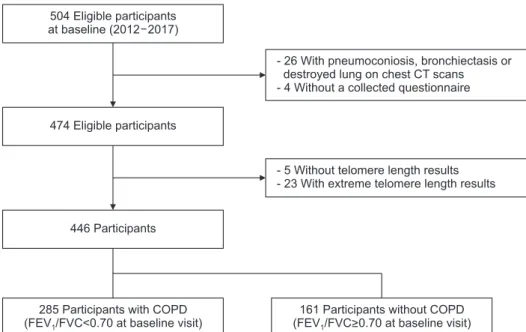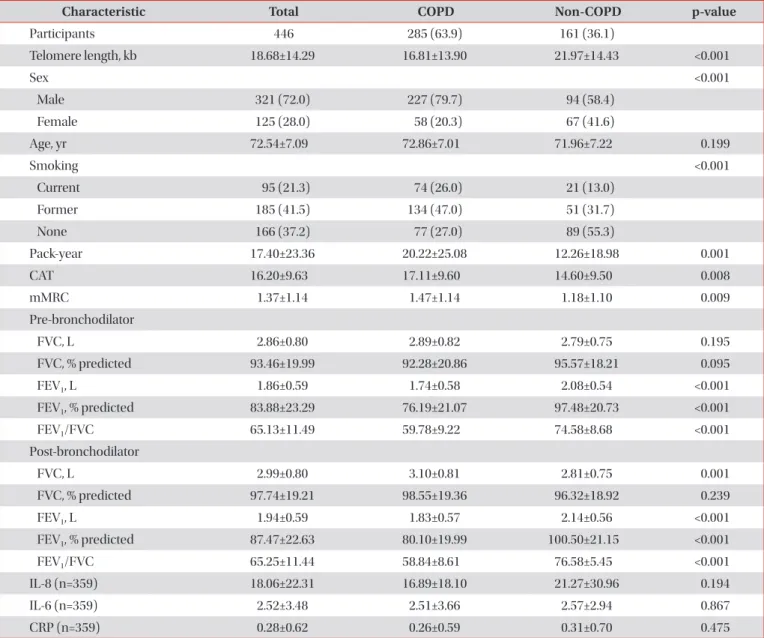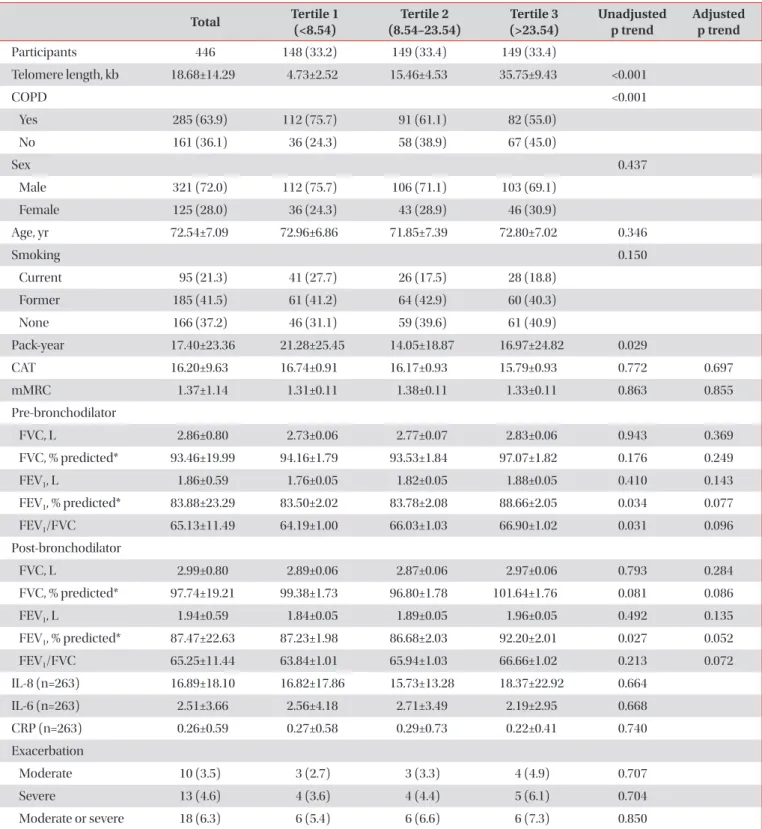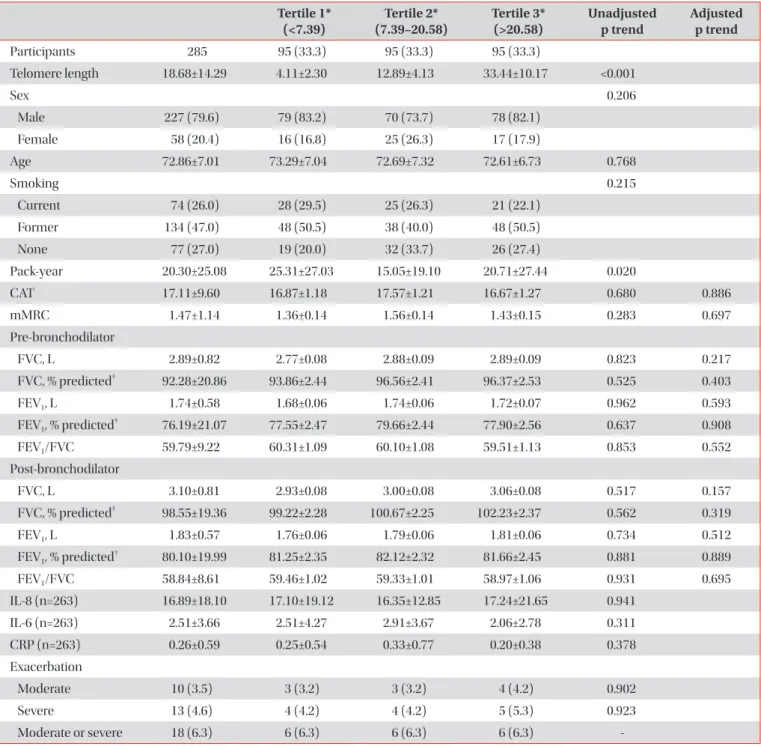Correlation between Telomere Length and Chronic Obstructive Pulmonary Disease–
Related Phenotypes: Results from the
Chronic Obstructive Pulmonary Disease in Dusty Areas (CODA) Cohort
Da Hye Moon, M.D., Ph.D.
1, Jeeyoung Kim, Ph.D.
2, Myoung Nam Lim, Ph.D.
3, So Hyen Bak, M.D., Ph.D.
4and Woo Jin Kim, M.D., Ph.D.
1,21
Department of Internal Medicine, Kangwon National University Hospital, Chuncheon,
2Department of Internal Medicine and Environmental Health Center, Kangwon National University School of Medicine, Chuncheon,
3Biomedical Research Institute, Kangwon National University, Chuncheon,
4Department of Radiology, Kangwon National University Hospital, Kangwon National University of School of Medicine, Chuncheon, Republic of Korea
Background: Chronic obstructive pulmonary disease (COPD) is a common chronic respiratory disease with increased prevalence in the elderly. Telomeres are repetitive DNA sequences found at the end of the chromosome, which progressively shorten as cells divide. Telomere length is known to be a molecular marker of aging. This study aimed to assess the relationship between telomere length and the risk of COPD, lung function, respiratory symptoms, and emphysema index in Chronic Obstructive Pulmonary Disease in Dusty Areas (CODA) cohort.
Methods: We extracted DNA from the peripheral blood samples of 446 participants, including 285 COPD patients and 161 control participants. We measured absolute telomere length using quantitative real-time polymerase chain reaction. All participants underwent spirometry and quantitative computed tomography scan. Questionnaires assessing respiratory symptoms and the COPD Assessment Test was filled by all the participants.
Results: The mean age of participants at the baseline visit was 72.5±7.1 years. Males accounted for 72% (321 participants) of the all participants. The mean telomere length was lower in the COPD group compared to the non-COPD group (COPD, 16.81±13.90 kb; non-COPD, 21.97±14.43 kb). In COPD patients, 112 (75.7%) were distributed as tertile 1 (shortest), 91 (61.1%) as tertile 2 and 82 (55%) as tertile 3 (longest). We did not find significant associations between telomere length and lung function, exacerbation, airway wall thickness, and emphysema index after adjusting for sex, age, and smoking status.
Conclusion: In this study, the relationship between various COPD phenotypes and telomere length was analyzed, but no significant statistical associations were shown.
Keywords: Telomere Length; Chronic Obstructive Pulmonary Disease; Phenotype
Address for correspondence: Woo Jin Kim, M.D., Ph.D.
Department of Internal Medicine, Kangwon National University School of Medicine, 1 Gangwondaehak-gil, Chuncheon 24341, Republic of Korea Phone: 82-33-258-9364, Fax: 82-33-255-6567, E-mail: pulmo2@kangwon.ac.kr
Received: Jan. 24, 2021, Revised: Apr. 10, 2021, Accepted: May. 12, 2021, Published online: May. 13, 2021
cc It is identical to the Creative Commons Attribution Non-Commercial License (http://creativecommons.org/licenses/by-nc/4.0/).
Copyright © 2021
The Korean Academy of Tuberculosis and Respiratory Diseases.
Introduction
Chronic obstructive pulmonary disease (COPD) is a major and increasing global health problem with large healthcare costs
1. COPD is a heterogeneous disease, it comprises of emphysema in the lungs parenchyma, large central airway inflammation, mucociliary dysfunction, bronchiolitis, and small airway structural changes
2. Airflow limitation, measured by reduced forced expiratory volume in 1 second (FEV
1), progresses very slowly over several decades. Therefore most patients with symptomatic COPD are in the late middle-aged or elderly. An accelerated rate of lung function decline with age is one of the central pathophysiological characteristics of COPD. Therefore COPD prevalence increases with age
1.
Telomeres are repetitive DNA sequences, with high G-C content, at the end of chromosome protection. They protect chromosomal ends from being recognized as double-strand breaks and therefore protecting them from end-to-end fusion and degradation
3. DNA polymerases cannot fully replicate chromosomes, because one RNA primer remains on each daughter DNA strand. This loss of base pairs is a partial con- sequence of the end-replication problem
4. Therefore, DNA cannot be duplicated at the end of the chromosome. Each duplication results in a gradual shortening of telomeres, until a critical length is reached at which point cells undergo apopto- sis
5. In addition, exposure to oxidative stress and inflammation aggravates this shortening
6. Based on this, some studies have shown that telomere length is a biomarker of cellular aging
7,8.
Several studies have shown a significant relationship be- tween reduced telomere length in peripheral blood leukocytes and increased risk of malignancy, cardiovascular disease, and diabetes mellitus
9-11. In these studies, leukocyte telomere length was used as a biomarker of aging based on the hypoth-
esis that it reflects the physiological age of individuals. Since COPD is an age-dependent process, assessment of telomere length may be useful for better understanding of the disease pathogenesis.
Since COPD is a heterogeneous disease with variable phe- notypes
12, in the present study, we assumed that the shorter the telomere length, the more depressed the lung function, and the higher the exacerbation rate and degree of emphy- sema. Accordingly, this study aimed to assess the relationship between telomere length and the lungs function, exacerba- tion, and visual assessments of emphysema as well as smok- ing exposure in a Korean COPD cohort residing near cement plants.
Materials and Methods
1. Study design and population
The Participants of the Chronic Obstructive Pulmonary Disease in Dusty Areas (CODA) cohort were analyzed
13. The CODA study enrolled participants living near six cement plants in the Kangwon and Chungbuk provinces of South Ko- rea. Overall, 504 participants (362 men and 142 women) were enrolled for baseline examinations between 2012 and 2017 (Figure 1). Twenty-five participants whose chest computed to- mography (CT) scans showed signs of pneumoconiosis, bron- chiectasis or destroyed lung were excluded, four were without completed questionnaire, five without telomere length results, and 23 with extreme telomere length results. Finally, a total of 446 participants were enlisted as eligible participants.
At baseline examinations, a medical interview and survey questionnaire were administered, and spirometry, physical
504 Eligible participants at baseline (2012 2017)
474 Eligible participants
446 Participants
285 Participants with COPD (FEV /FVC<0.70 at baseline visit)1
- 26 With pneumoconiosis, bronchiectasis or destroyed lung on chest CT scans - 4 Without a collected questionnaire
- 5 Without telomere length results - 23 With extreme telomere length results
161 Participants without COPD (FEV /FVC>0.70 at baseline visit)1





